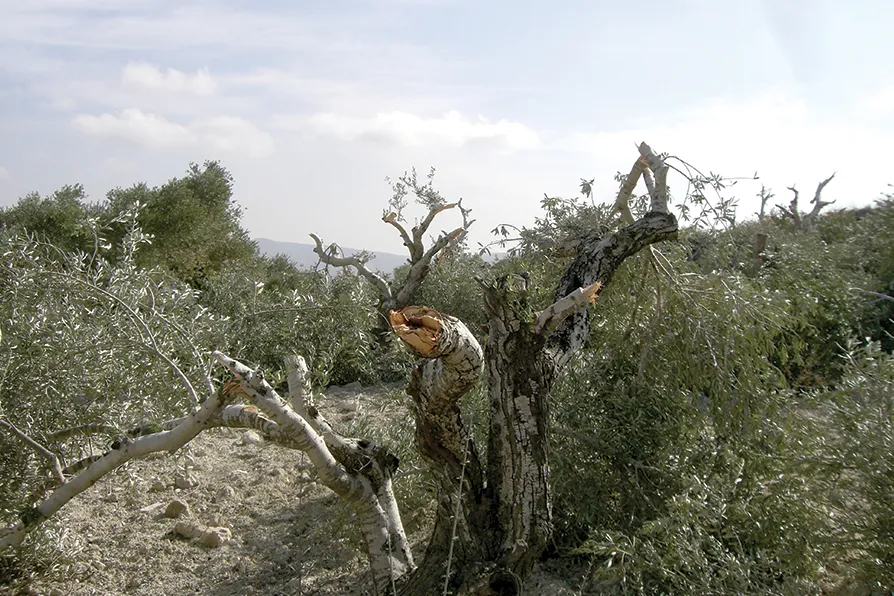Once the bustling heart of Christian pilgrimage, Bethlehem now faces shuttered hotels, empty streets and a shrinking Christian community, while Israel’s assault on Gaza and the tightening grip of occupation destroy hopes of peace at the birthplace of Christ, writes Father GEOFF BOTTOMS
Olive oil remains a vital foundation of food, agriculture and society, storing power in the bonds of solidarity. Though Palestinians are under attack, they continue to press forward write ROX MIDDLETON, LIAM SHAW and MIRIAM GAUNTLETT

 GETTING AWAY WITH MURDER: Settlers from Yitzhar settlement, south of Nablus, cut down 97 olive trees in the village of Burin, 2009 / Pic: ISM Palestine/CC
GETTING AWAY WITH MURDER: Settlers from Yitzhar settlement, south of Nablus, cut down 97 olive trees in the village of Burin, 2009 / Pic: ISM Palestine/CC
Science and Society
OLIVES are one of the cornerstones of agriculture, a crop that has been harvested and traded since at least 4500 BCE by people all across the Mediterranean and West Asia.
For thousands of years, olive farmers have picked olives to mash and press them for the large quantity of valuable oil that comes out. Olive oil is a prized cooking staple, but prior to the invention of electricity, it was also a vital fuel used in lamps.
Oils are largely composed of hydrocarbons, which are long chains of carbon atoms with hydrogen atoms clustered along their length. These hydrocarbons obtain their properties from a clutch of atoms at one end, known as the functional group, as well as from the bonds between the carbons in the chain.
Specifically, it is the bonds between the carbon neighbours, tightly locking them together, which makes oil so valuable as a fuel.
As oils burn, the energy locked up in the bonds that has kept the carbons together is released. The tight binding of neighbour atoms is a power so valuable that it has kept the olive tree a foundation of societies around the Mediterranean for thousands of years.
The long and strongly bonded chains produce the oil’s slow-flowing viscosity. The tightness of the bonds reduces the oil’s reactivity to air, allowing it to reach high temperatures.
In each chain of an olive oil molecule there is just one free floating bond that isn’t attached to a hydrogen or carbon. This spare bond is available to react — the molecule is not “saturated” (because there is only one of them, the fat is called “monounsaturated”).
That low reactivity means the oil doesn’t go rancid, which explains its use as a preservative. When something else is preserved in oil, it too is protected from reacting with the air by a coating of the long strong chains.
All our energy use is a question of the capture, storage, transport and release of energy.
The way that energy is locked up in carbon-carbon bonds is a particularly potent image. Living organisms of many kinds lock up energy in carbon bonds, using the complex chemical pathways in our bodies, in which enzymes play a crucial role. That fat can be stored in the organism’s body, or outside it, in food.
Although the energy can be released again through other complex pathways through digestion, it can also be released through burning to produce light and heat. In fact, though olive oil is no longer a dominant fuel source, the fossil fuels that we burn are the transformed remains of biological organisms that lived long ago.
The molecules have been transformed through the addition of more energy from the intense subterranean heat and pressure, but incorporated in the original material, and further transformed, are the carbon-carbon bonds that give oil its strength.
Since 2023, the price of olice oil has increased radically. A principal factor in the price rise was that year’s dramatically low harvest.
Drought in Spain diminished the yield significantly — as well as in Greece and Italy. Olive trees are adapted to hot, dry conditions, but they still require some water. Since a likely consequence of climate change is increased risk of these droughts, olive crops are threatened.
Another damaging threat to olive harvests is a disease, Xylella fastidiosa. This is a bacteria that lives in the xylem, the water vessels of the plant.
In Europe this is a 21st-century disease, introduced since 2011 via plants moved from North America. It is causing significant alarm, as it damages a wide range of crops, and as yet has no reliable cure.
The bacteria gets into the stem of a plant through insect bites, and then proliferates in the xylem — the water-carrying vessels.
It makes a film that coats the insides of the vessels and blocks water from travelling through the plant, causing death of branches and leaves, and eventually choking the plant, decimating the harvest.
But the bonds in the oil of olives are not the only bonds that they produce. The trees normally live for hundreds of years, and some individual trees living today are more than 2000 years old.
Their immense lifespan means that the tradition of olive tree cultivation and harvest has created strong bonds between communities and the land. Nowhere is this more obvious than in Palestine.
Olive trees and the olive harvest became solidified as potent symbols of resistance when Israeli occupying forces began to destroy and control access to olive groves in the early years of invasion and illegal settlement, and remain so today.
Olives are a major industry in Palestine, taking up the majority of all cultivated land in the country.
Olive grove cultivation and harvesting is estimated to be the main source of income for 80,000-100,000 families. The value of Palestinian olive oil trade is estimated to be worth £75-143 million, depending on the harvest.
It is this harvest that is made a weapon of war by the Israeli occupation. Destruction of olive groves and violent attacks on farmers are part of the development of illegal settlements in the occupied territories.
The government tightly limits access of Palestinian farmers to their trees, meaning a large proportion of the olives go uncollected.
Soldiers have also been reported firing directly on, and killing, Palestinians working in olive groves, and systematically destroy trees.
Al-Haq reported this year that 75 per cent of olive trees in Gaza have been destroyed by Israel since 2023, further reducing the livelihood and source of food for Gazans.
As Gaza lives through this murderous war-induced famine, the attack on the source of food and energy is particularly bitter.
Nevertheless, just like the powerful bonds in the oil they harvest, the bonds that hold people together carry the energy of their survival.
As a symbol of resilience and resourcefulness, the olive tree is unmatched. Where refugees have set up home, they have cultivated UNRWA (United Nations Relief and Works Agency) for Palestine Refugees — donated olive trees, and continue to harvest them.
During the brief ceasefire in Gaza, people went to harvest olives. Distaste for economic argument shouldn’t blind us to the material importance of olives in sustaining people.
Palestinian organisations focused on olive cultivation abound — planting new trees, protecting farmers, speeding up the olive harvest with new agricultural tools.
The Palestinian ministry reported that the olive harvest in 2024, despite attacks from Israeli officials and militants, beat their predictions by an extra 50 per cent in volume and generated £138 million.
Tens of thousands of olive trees might be uprooted, but new ones are planted, and new generations harvest olives for their oil. Some bonds cannot be broken.

New research into mutations in sperm helps us better understand why they occur, while debunking a few myths in the process, write ROX MIDDLETON, LIAM SHAW and MIRIAM GAUNTLETT

ANN CZERNIK looks back over the last two years of carnage that began with the unprecedented October 7 operation and considers the rhetoric from both sides in light of the massacre carried out by Israel that has united the world in horror












